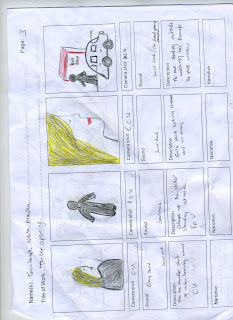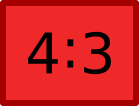For our video unit we had to get ourselves into groups and film and edit an opening scene for a thriller. I chose to work with Priscilla and Toni Leigh as we all work well as individuals and have different strengths in video. In our groups we had to plan, storyboard our idea, and decide on the characters and actors. We decided to base our thriller opening around a young girl and her stalker. In the groups we all contributed to doing the storyboard, Priscilla and I did the drawings and Toni- Leigh filled in the descriptions. We also had to decide who would be taking out the camera and tripod, it was decided that I would as part of the filming was to be done at my home. We decided as a group to name the film Rebecca as the thriller would be based around the main character we see.
The filming was done over a period of three days which went very well. The week after filming we were then able to capture our video footage in Final Cut Pro, which is the non linear editing software that we used to edit. Once we had captured and looked back on all the different shots we were then able to begin the editing process. We felt there was no need for a re- shoot, as the shots we filmed had been done well, although looking back on it some of the shots could have been re done so that it lasted a little bit longer and enabled us to have more to play with in Final cut pro. The inside house shots was one of the poor shots we filmed as the colour balance hadn’t been done properly. Because of us not re- shooting some of our video work it made editing a bit harder as some of the shots ended earlier then we had intended and couldn’t be made longer, such as the bus scene which we wanted to have a longer clip of but couldn’t have because the camera had been stopped too early during filming.
The bus scene wasn’t the only scene we had problems with during the editing process, we also found it difficult to find music which would fit in really well with the type of thriller we were doing and the emotion we were trying to convey to an audience. In the end we found music, a copyright free track from a CD with copy right free music that was perfect for the beginning of the opening sequence. Fitting the music in with the clips however was difficult as we wanted clips of the stalker board to fade to black at certain points in the music to build up suspense. In the end we managed to pull this off but it took a long time and we had to adjust a lot of the clips in a film. Within the group we each took turns at editing in the lesson and contributed our thoughts and ideas on where cross dissolves should be used and how low the music should be dipped. We used music software called Soundtrack pro, which had a pre recorded track that went well with the second part of our opening film sequence and we decided to use. We also got our sound clips such as the dramatic boom at the end of our opening sequence and the camera sounds used in shots where there were pictures taken of Rebecca from soundtrack pro. Before we had finished our opening for a thriller we were taught by the technician how to de interlace and export in Final cut pro so that when we were finished we knew how to change the file into a smaller file format that could be put on DVD or played on other devices. My role during the editing process was different in each editing session, when I wasn’t on the computer than I would be responsible for making sure that the film sequence was looking smooth. At the end of the film sequence checks were done to see if there were any audio peaks in any of the sound, and to see if any luminance correction was needed in areas of the film sequence. These checks were done to get us into the practice of professional editing and exporting.
The whole editing process went well and there were only a few bumps along the way that we were able to easily resolve. Watching our thriller back I think the music we decided to use worked well and fitted in with the contraventional of music generally used in thrillers and added to the build up of suspense. However during feedback, a member in the class felt that for an opening too much of the thriller’s plot of the story had been given away, although this was what we had intended as a group. I think our thriller was quite conventional as it contained enigmas and built up suspense in areas such as the bus scene were the stalker suddenly disappears. The gloved hands of the stalker also added to the suspense and creepiness of the film sequence. Other feedback we got about our thriller opening was that the ending seemed more trailer like then an opening, we had not intended for the end of film sequence “Rebecca” to come across like this, therefore if I could make a change it would be that the end of the opening doesn’t look trailer like and more like it’s about to carry on. I would have done this by inserting and extra shot after the film title and then fading out to give the illusion of the film carrying on. Other changes I would make to our opening sequence would be to the pictures used at the beginning of the film sequence, so that there’s more of a contrast in the pictures used in the beginning of the opening. Another change would have been to the scene where the victim is in her house, the colour balance had not been done properly which resulted in the shot looking more yellow, Priscilla and Toni Leigh had tried to change this by adjusting the colour balance on Final cut pro but it made the shot look a little washed put. The acting during the phone call slightly made the thriller seems less serious.
The things that worked well and we received positive feedback for were the stalker’s collage which added a lot of suspense. The bus scene which we had experimented with, worked out very well in the end and the feedback received on the shot was very positive. The music complimented the shots and the thriller opening overall was well shot but needed more different camera angle shots. The story line fitted with in with the convention of thriller’s however during feedback one person felt it was a bit “cliché”.
Overall I think the filming and editing of our opening film sequence “Rebecca” went well, and as a group we worked well together. We all contributed our ideas in the unit and distributed the planning and work fairly and evenly.










